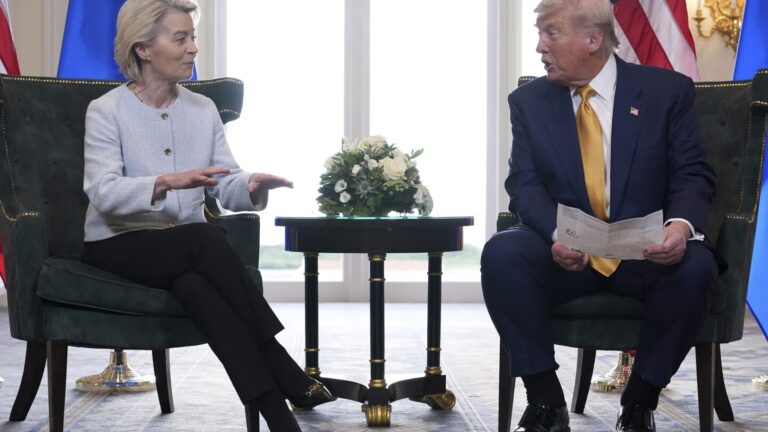BRUSSELS (AP) — U.S. President Donald Trump’s administration and European Union officials on Thursday released a bare-bones account of their trade deal that imposes a stiff 15% import tax on 70% of European goods exported to the U.S., but they left blank key areas including wine and spirits and steel and indicated that talks would continue on those and a slew of other important goods.
The two sides said that the document made public Thursday was only “a first step in a process that can be further expanded to cover additional areas.” They are dealing with the vast range of goods traded between the two economies in what is the largest bilateral trading relationship in the world, involving $2 trillion in annual transatlantic business.
The 3 1/2-page text, which represents a political commitment and isn’t legally binding, contrasts with the typical format for trade agreements, which can be hundreds of pages long and carry legal force.
The key provisions are the 15% tariff on most EU goods, a zero rate on U.S. cars and other industrial goods exported to the EU, and a range of exceptions to the 15% rate for aircraft and aircraft parts, generic pharmaceuticals and pharmaceutical ingredients, with other sectors to be added for goods crucial to each other’s economies. Those goods would face lower tariffs from before Trump’s tariff onslaught.
One goods category that wasn’t excluded from the higher tariff was wine and spirits, which had enjoyed zero tariffs on both ends since 1997. The EU’s chief trade negotiator, Maros Sefcovic, said that EU officials had not won an exemption “yet” but hoped to in future talks and that “doors are not closed forever” on that issue.
Proposals to exempt a certain amount of EU steel imports, known as a tariff rate quota, have been left unresolved pending more talks.
The 15% tariff is much higher than tariff levels on both sides from before Trump launched his wave of tariffs, when they averaged in the low single digits. The tariffs are paid on the U.S. end — either absorbed by U.S. businesses importing the goods, lowering their profits, or passed on to American consumers in the form of higher prices at the cash register.
European officials have had to defend the deal against dismay from businesses and member governments at the higher tariff and criticism that the EU gave away too much. Commission President Ursula von der Leyen sold the deal as granting quick relief from the even higher U.S. tariff on EU cars of 27.5% and as opening the way for further negotiations that could exclude more goods from the 15% tariffs. The deal provides that the lower tariff on cars would apply retroactively from Aug. 1 if the EU can introduce legislation to implement its part of the deal by then, which EU officials say they will do.
“Faced with a challenging situation, we have delivered for our member states and industry and restored clarity and coherence to transatlantic trade,” von der Leyen said. “This is not the end of the process.”
Sefcovic, who echoed those sentiments, said, “The alternative was a trade war with sky high tariffs … it builds confidence. It brings stability.”
The deal also includes nonbinding EU commitments to purchase $750 billion in U.S. energy and for EU companies to invest $600 billion in the U.S. In both cases, the money would come from private companies and is based on assessment by the European Commission on what companies were planning to spend.
___
McHugh contributed from Frankfurt, Germany, and Hussein from Washington.


